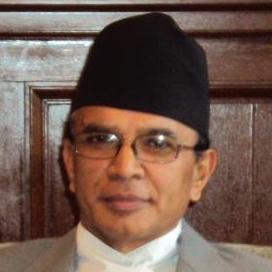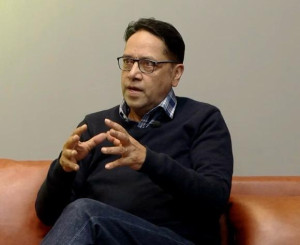Books
Treatise on a Genius Par Excellence
The book Yadunath Khanal: Bidwaan Kutnitijna Samaalochak by Jaya Raj Acharya is a comprehensive biography of one of Nepal’s ace diplomats.
Madan Kumar Bhattarai
While many who knew the late Yadunath Khanal (1913-2004) know him as an ace diplomat. But Khanal was more than that. He wore many hats as a writer, academician, administrator, speechwriter, etc.
The book Yadunath Khanal: Bidwaan Kutnitijna Samaalochak, which roughly translates to Yadunath Khanal: Scholar, Diplomat and Critic, by Jaya Raj Acharya is a very important book that exhaustively covers Khanal’s life. The author is a relative of Khanal and enjoyed long personal and academic interactions with him, making him an eminently qualified person to write such a comprehensive volume on Nepal's ace diplomat.
Besides being a brilliant student, prolific writer and scholar with flair in Nepali, Sanskrit and English languages, Acharya is also a diplomat himself and served as foreign policy adviser to the late Prime Minister Girija Prasad Koirala before being appointed Nepal's Permanent Representative to the United Nations, New York.
The book’s front cover includes the first day issue of the postage stamp with the portrait of Yadunath Khanal affixed by the Department of Postal Services on December 31, 2019 to honour the veteran scholar.
The back cover has a photo taken by seasoned journalist and analyst Dhruba Hari Adhikary of Khanal and Acharya. The photo was taken just five days prior to Khanal’s demise.
Khanal served with King Mahendra—who was known for his exemplary tact and initiative in diversifying the ambit of Nepal's foreign relations—and King Birendra—an epitome of decency who sought to focus on striking a balance between diplomacy and zone of peace.
Acharya wrote the first book on Khanal eighteen years ago and it was titled Yadunath Khanal: Jivani Ra Vichaar, which translates to Yadunath Khanal: Life and Thought. The present book is, in essence, the second edition with a few changes in some chapters and considerable value additions in the form of photos, maps, and several documents under appendices. The new book with 19 chapters has 23 appendices serving as a veritable mine of information as compared to only nine in the first edition.
The book’s first three chapters covers Khanal's ancestors and parentage, his childhood days, and marriage and education, respectively. The fourth chapter deals with his time as a professor of English at Trichandra College, his forays into literature, a year-long stint at the London University, and a select list of his students who excelled in public life. Khanal's participation in the historic and pathbreaking Bandung Conference of Asian African countries in 1955 is detailed in chapter five.
The subsequent chapter deals with his initiation into civil service as the Secretary to Prime Minister Tanka Prasad Acharya. The chapter also covers the period when Khanal served as the home secretary and his role in the promulgation of the civil service act and waiving the ban on Nepal Communist Party. He was also sent to Oregon University as a preparatory exercise to eventually make him the first Vice-Chancellor of Tribhuvan University. While he never became the vice-chancellor, he did become a member of Yojana Mandal (planning body).
Chapters eight, nine and ten, respectively, deal with Khanal's appointment as foreign secretary, ambassador to India, and his second stint as foreign secretary that fully established him as the topmost exponent of Nepal's foreign policy both in terms of formulation and practice, and scholarly inputs in the form of speeches, articles, books and advices. For reasons not fully comprehended, he opted out of government service after three years of his second term as foreign secretary.
Chapter eleven marks his return to the academic world in the form of fellowship at the Center for International Affairs, Harvard University, resulting in the preparation of a comprehensive research work on Nepal's foreign policy until the tail end of King Mahendra’s rule.
After King Birendra ascended the throne on January 31, 1972, Khanal was appointed to Tribhuvan University Service Commission and chapter 12 is dedicated to this period of Khanal’s life.
Chapter thirteen is devoted to his assumption of the plum post of the ambassador to the United States where he received triumphal reception from both President Richard Nixon and America’s intellectual and academic community.
Chapter fourteen is about Khanal's appointment as chairman of the Public Service Commission, which made him the second head of foreign office to assume the post—the first one being Munshi Sardar Nagendra Man Singh Pradhan. Likewise, chapter fifteen depicts his entry into active diplomacy once again as the ambassador to China. His return from China in 1982 signalled the end of his active involvement in government.
The three subsequent chapters respectively deal with his academic exercises after returning from Beijing, his views on Nepal after democratic restoration as he served as adviser to the Prime Minister, and his reflections on Nepali literature. The nineteenth and last chapter summarises Khanal as a reader par excellence much more than anything else including assumption of key positions and assignments during his nonagenarian life.
In a nutshell, Acharya has rightly presented Khanal—a true adherent of the maxim, ‘plain living and high thinking’—as a seasoned diplomat who made important contributions in his many roles as a teacher, litterateur, planner, administrator, diplomat, and, last but not the least, a speech writer and wordsmith who kept the audience spellbound, diplomats soul-searching and the younger generation deeply motivated and refreshed.
Acharya's treatise is an exemplary work in terms of coverage and analysis of the contributions of one of the most famous veterans of Nepali society who dominated the scene for almost six decades. While I have all the admiration for the author, I have not been able to reconcile with his decision to shift the landmark sketch of Khanal by the then Crown Prince Birendra from the front cover in the first edition to inside pages in the current edition.
Left to myself, I would have retained the historic and unprecedented sketch made by one of the most ardent fans of Khanal's writings in the front cover and keep the special postage portrait inside. Since the author has not given any reason for doing so, I am not sure if he has any other logic behind his decision. With this humble reservation, I wish to offer congratulations to the writer for his illustrious publication.
Yadunath Khanal: Bidwaan Kutnitijna Samaalochak
Jayaraj Acharya
Publishers: Pairavi Prakashan, Kathmandu, 2020
Pages: 402
Price: Rs. 745




 12.12°C Kathmandu
12.12°C Kathmandu











